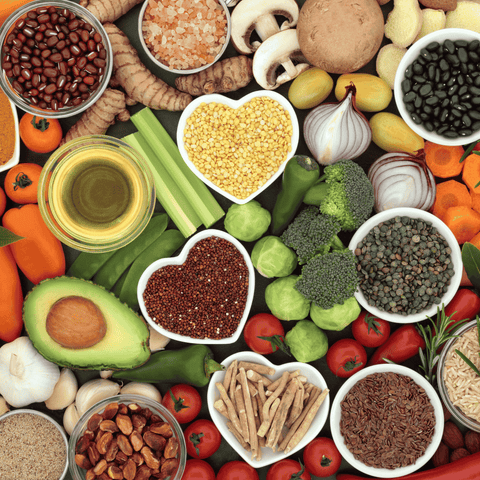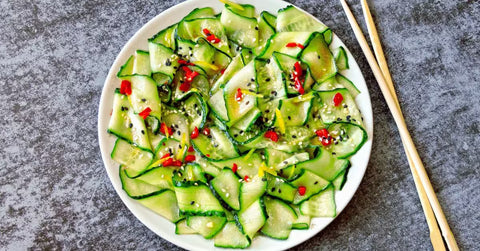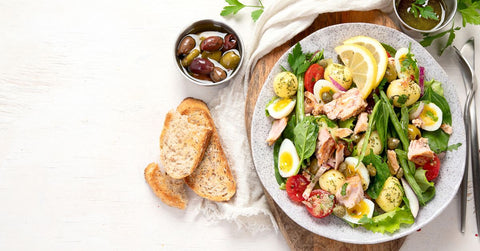
Updated: August 5, 2025 • Seven-minute read. By Charles Piedboeuf
Pescetarian: What exactly is it?
You often hear about the pescetarian diet, but you're not sure what it entails? Being pescetarian means adopting a vegetarian diet enriched with fish and seafood 🐟. You exclude red meat and poultry, but you enjoy the richness of seafood, vegetables, grains, legumes, eggs, and dairy products according to your desires.
This choice is increasingly appealing because it combines the benefits of a plant-based diet, while offering the flexibility of marine sources: omega-3, complete proteins, vitamins D and B12. Pescetarianism appeals to those who want to eat healthier, reduce their environmental impact but still enjoy grilled fish, sushi or a fresh shrimp salad. 🥗
Why choose this lifestyle?
Adopting a pescetarian diet means first and foremost taking care of your health without depriving yourself. Oily fish (salmon, sardines, mackerel, etc.) are an excellent source of essential fatty acids, known to protect the heart and brain. Vegetables, legumes, and grains round out the diet, limiting the risk of deficiencies and promoting diversity.
From an ethical perspective, many people appreciate reducing their consumption of animal meat, particularly for animal welfare or ecological reasons. Sustainable fishing and labels (MSC, organic, local fishing) also allow for more responsible choices. Finally, this lifestyle is often more convivial: you can share varied meals without feeling excluded during barbecues or brunches with friends. By the way, discover our special barbecue inspirations for summer! 🔥
How to balance your meals
Adopting a pescetarian lifestyle also means learning to create complete menus. The ideal? Vary your protein sources: alternate between oily fish and lean fish, eggs, tofu, chickpeas, quinoa, etc. Remember to include colorful vegetables in each meal, whole grains (brown rice, semi-whole-wheat pasta, bulgur), and good oils (rapeseed, olive).
When it comes to cooking, keep it simple to preserve nutrients: steam, foil, griddle, or air fryer (for quick and easy cooking!). For smoothies for breakfast or as a snack, a good blender lets you mix fresh fruit, seeds, and plant-based milk.
A little tip: remember to vary your fish species to limit your exposure to heavy metals (avoid eating tuna several times a week, for example). And for iodine, seaweed is a valuable ally!
Economical tips and organization
People sometimes think that eating pescatarian is expensive, but there are plenty of ways to stay within your budget. Choose seasonal and local fish, which are often more affordable at the market than in supermarkets. Canned sardines or mackerel are economical, rich in nutrients, and have a long shelf life—perfect for when you're in a pinch!
Plan your meals in advance: make a large roasted vegetable platter or a mixed salad for several meals. You can cook larger quantities and freeze them in individual portions. Don't hesitate to check out promotions on fresh or frozen seafood: some stores offer anti-waste baskets at reduced prices.
Bonus tip: Reuse leftovers! A grilled salmon fillet from lunch becomes a filling for wraps or homemade maki rolls in the evening. And for healthy appetizers, spread tuna rillettes on toast with a squeeze of lemon… guaranteed success!
Recipes, tools and inspirations
Pescetarianism isn't just about steamed fish! Let your creativity run wild in the kitchen: marinated salmon poke bowl, coconut shrimp curry, spinach-ricotta-salmon lasagna, or veggie & fish burgers with air-fryer sweet potato fries.
Need some quick inspiration? Check out our comparison of the best air fryers of 2025 for healthy cooking, or explore our selection of blenders for vitamin-packed smoothies. For summer grilling, head to our barbecue collection – something to delight everyone, pescatarian or not!
Organizational tip: Equip yourself with a batch of airtight containers and a meal planner. Save time, avoid waste, and vary your mealtimes each week.
Frequently asked questions about pescetarianism
Is pescetarianism suitable for the whole family?
Yes, as long as you adjust the portions for children and vary their intake. Remember to include enough starchy foods and dairy products for younger children.
How to avoid deficiencies?
Alternate between fish, eggs, dairy products, legumes, and grains. Remember to regularly consume oily fish for vitamin D and sources of iodine (seaweed, shellfish).
Can you eat pescatarian at a restaurant?
Many restaurants now offer at least one fish or seafood option. Don't hesitate to ask for a vegetarian or pescatarian adaptation.
Is pescetarianism good for the environment?
It reduces your carbon footprint compared to a meat-based diet, especially if you choose sustainable and local fishing. Beware of overfishing: learn about labels and species to avoid.









Comments (0)
There are no comments for this article. Be the first one to leave a message!